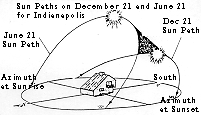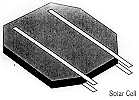

History of the Hydro-Ram
How it works
Do I need a Hydro-Ram?
Water output
Operational requirements
Descriptive picture
Solar pumps
Solar submersible pumps
Submersible packages
Prices and features
Free evaluation
SOMETHING EXCITING UNDER THE SUN
|
WE'RE PROUD TO INCLUDE SOLAR PUMPS TO OUR GROWING FAMILY OF
QUALITY PUMPS.
|
Lightweight
Portable Efficient Quiet Reliable And They Run on FREE Energy from the Sun. |

|
|
SOLAR
SUBMERSIBLE PUMP |
This diagram illustrates the path of the sun over varying seasons.
Remember when selecting a site for your solar modules to pick
a spot that is clear of shade from a minimum of 10 a.m. to 2 p.m.
on December 21st. Even a limb from a deciduous tree will substantially
reduce power output.
|
The Solar Submersible pump is probably the most efficient, economical and trouble free pump of all water pumps. Fasten a pipe and wire to the pump and toss it in the water (lake, pond, well, or river), hook other end of the wire to a solar panel, then point the panel toward the sun and up comes the water. The pump is lightweight and easily moved. It yields hundreds of gallons per day to a point over 200 feet above the source. It will not be damaged if the pump runs dry for a short time.
Pumping water with solar power is using a reliable, inexpensive combination of submersible pump and solar cell panel is available for less than $1,800. A more sophisticated system can be bought for under $2,500.
Engineers have spent years in developing a water pumping system to meet the needs of ranchers, farmers, and homesteaders. The system is a reliable and affordable system that can be set up by a person with no experience and very little mechanical or electrical know how.
The Solar submersible water pump has no match in flat country or where there is no falling water or electricity. If your system is equipped with a battery bank to store energy, water can be pumped at any time, morning, noon, or night and on cloudy days. The system will pump water on demand. It requires very little maintenance. Installation is quick and easy. All at a price that's affordable.
If you have water and no electricity then a solar or ram pump is what you need.

How does a solar water pumping system work?
Solar modules are usually installed on special ground or pole mounting structures. For more output, modules are installed on a tracker - a mounting structure that follows the sun like a sunflower.
Solar electricity may be used directly or it may be stored in batteries for later use. The batteries used for most systems are slightly different than ones used in cars. They are called deep-cycle batteries and are designed to be rechargeable and to provide a steady amount of power over a long period of time.
The
Ram Company
1-800-227-8511
(Virginia)
512 Dillard Hill Road
Lowesville, VA 22967
Email rhfleming@earthlink.net